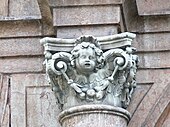Festoon
This article includes a list of general references, but it remains largely unverified because it lacks sufficient corresponding inline citations. (February 2014) |

A festoon (from French feston, Italian festone, from a Late Latin festo, originally a festal garland, Latin festum, feast) is a wreath or garland hanging from two points, and in architecture typically a carved ornament depicting conventional arrangement of flowers, foliage or fruit bound together and suspended by ribbons. The motif is sometimes known as a swag when depicting fabric or linen.[1][2]
In modern English the verb forms, especially "festooned with", are often used very loosely or figuratively to mean having any type of fancy decoration or covering.
Origins and design[]
Its origin is probably due to the representation in stone of the garlands of natural flowers, etc., which were hung up over an entrance doorway on fête days, or suspended around an altar.[2]
The design was largely employed both by the Ancient Greeks and Romans and formed the principal decoration of altars, friezes and panels.[2] The ends of the ribbons are sometimes formed into bows or twisted curves; when in addition a group of foliage or flowers is suspended, it is called a drop or margent.
The motif was later used in Neoclassical architecture and decorative arts, especially ceramics and the work of silversmiths. Variations on the exact design are plentiful; for example, the ribbons can be suspended either from a decorated knot, or held in the mouths of lions, or suspended across the tops of bucrania as in the Temple of Vesta at Tivoli.
Gallery[]

Detail of the Hellenistic mosaic floor panel, from the 2nd century BC, in the Pergamon Museum (Berlin, Germany)

Trompe-l'œil wall painting from a Roman villa, with festoons and bucrania, circa 50-40 BC, in the Metropolitan Museum of Art (New York City)
Frieze with festoons and bucrania, in the Ephesus Archaeological Museum (Selçuk, Turkey)
Highly decorated Roman sarcophagus, with two festoons, circa 130-125 BC, in the Louvre

Pair of festoons hanged in the mouth of a lion, upside a door from Paris

Pair of festoons at the entrance of the Église Saint-Paul-Saint-Louis (Paris)
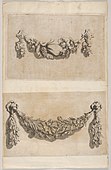
Two etchings of two designs of festoons, from 1694, in the Metropolitan Museum of Art

Design for a frieze with wreath and festoons, from the 18th century, in the Metropolitan Museum of Art
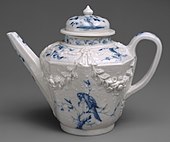
Hard-paste porcelain teapot with reliefs of festoons, 1720–1727, in the Metropolitan Museum of Art
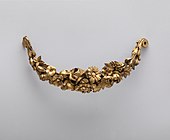
French gilt bronze festoon, 18th century, in the Metropolitan Museum of Art

Cupid seated on a festoon made of flowers, circa 1770-1790, in the Metropolitan Museum of Art

19th century design of a vase decorated with festoons, in the Cooper Hewitt, Smithsonian Design Museum (New York City)

Frieze with festoon in Bucharest (Romania)

Stuccos with festoons in a house from Bucharest
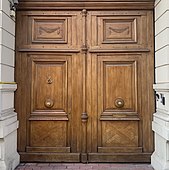
Door in Bucharest, decorated with a pair of swags in its upper parts
See also[]
References[]
- ^ Fleming, John; Honour, Hugh; Pevsner, Nikolaus (1986) [1966]. Dictionary of Architecture (3 ed.). Penguin Books Ltd. p. 114. ISBN 0-14-051013-3.
- ^ Jump up to: a b c Sturgis, pp. 22-23
Further reading[]
- Lewis, Philippa; G. Darley (1986). Dictionary of Ornament. New York: Pantheon. ISBN 0-394-50931-5.
- Sturgis, Russell (1901). A Dictionary of Architecture and Building, Volume II. New York: Macmillan.
- Attribution
- This article incorporates text from a publication now in the public domain: Chisholm, Hugh, ed. (1911). "Festoon". Encyclopædia Britannica (11th ed.). Cambridge University Press.
External links[]
 The dictionary definition of festoon at Wiktionary
The dictionary definition of festoon at Wiktionary
| Wikimedia Commons has media related to Festoons. |
- Architectural elements
- Ornaments (architecture)



















